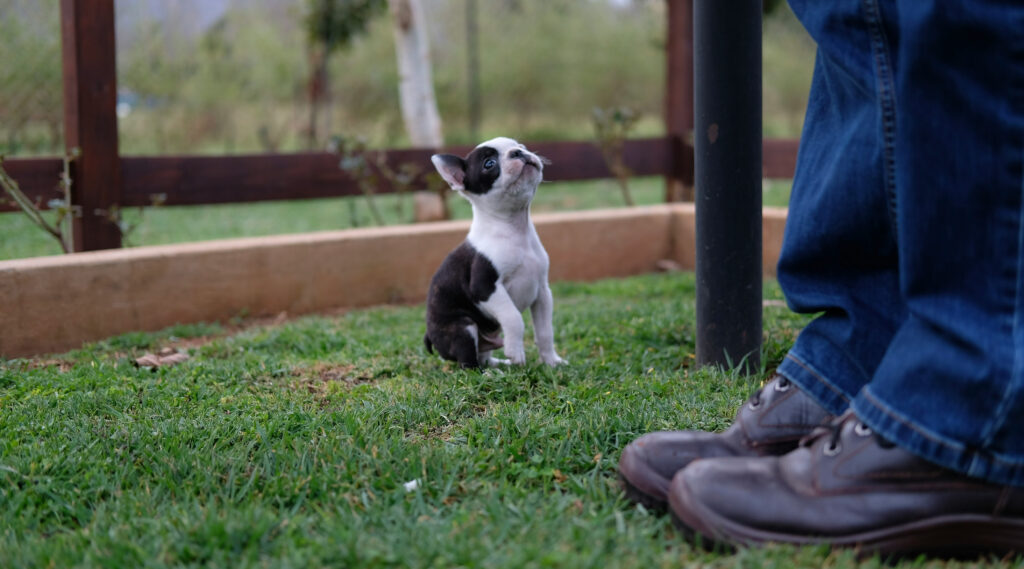After working with many rescue dogs over the years, I can tell you that these three commands — sit, stay, and come — are absolute game-changers. They’re not just about having a “well-behaved” dog (though that’s nice too). These commands can literally save your dog’s life.
I’ve seen dogs who knew “stay” avoid running into traffic, and dogs with solid recall come back from potentially dangerous situations. Plus, a dog who understands these basics is so much easier to live with and help when they’re stressed or overwhelmed.
⚠️Disclaimer: Every dog learns differently. These are general guidelines — if you’re working with a dog who has behavioral issues or trauma history, consider working with a professional trainer.
Teaching “Sit” — Your Foundation Command
This is where I start with every dog because it’s usually the easiest win. Even anxious rescue dogs can often master this quickly, which builds their confidence.
- Hold a treat close to your dog’s nose — let them smell it but don’t let them grab it
- Slowly move your hand up and slightly back — their head will follow the treat, and gravity will naturally lower their rear end
- The instant their bottom touches the ground, say “Sit!” and immediately give the treat with enthusiastic praise
Here’s the key: timing matters more than perfect form. The moment that butt hits the ground, mark it and reward it. I practice this for just a few minutes at a time, several times throughout the day.
With some of the more stubborn dogs I’ve worked with, I’ve found that using their dinner kibble instead of special treats can work wonders — they’re hungrier and more motivated.
Teaching “Stay” — Building Self-Control
Stay is really about impulse control, which some dogs find much harder than others. I’ve worked with border collies who picked this up in a day, and hounds who took weeks to understand they shouldn’t follow every interesting scent that drifted by.
- Start with your dog in a solid sit
- Hold your palm up like a stop sign and say “Stay”
- Take just one small step backward — if they hold position even for a second, immediately return and reward
- Gradually increase distance and duration — but never both at the same time
The biggest mistake I see people make is rushing this. If your dog breaks the stay, don’t get frustrated — just go back to an easier version they can succeed at. I always tell people: “Make it so easy they can’t fail, then slowly make it harder.”
Teaching “Come” — The Ultimate Safety Command
This one is personal for me. I’ve helped reunite too many lost dogs with their families, and the ones with solid recall training always had much better outcomes.
- Start with a long leash in a safe, enclosed area
- Get down to their level, use a happy voice, and say “Come!”
- If they don’t move toward you immediately, gently guide them with the leash
- When they reach you, make it the best thing that’s ever happened — treats, praise, maybe even a little play session
Never, ever call your dog to come and then do something they perceive as negative. I learned this lesson early when working with a rescue who’d been called over just to be crated or scolded. It took months to rebuild his trust in the “come” command.
My Training Philosophy
Keep sessions short. Five to ten minutes max. Dogs learn better in short, frequent sessions than long, exhausting ones. Plus, you want to end on a positive note while they’re still engaged.
Use what motivates your individual dog. Some dogs work for kibble, others need high-value treats like chicken or cheese. I’ve worked with dogs who were more motivated by praise and petting than any food reward.
Practice in boring places first. Master these commands in your living room before trying them at the dog park. You’re setting your dog up for success, not testing their limits.
Why These Commands Matter
I’ve seen these basic commands transform the relationship between dogs and their families. A dog who sits politely instead of jumping makes everyone more comfortable. A dog with a solid stay can be kept safe while you answer the door or pick up something they dropped. And reliable recall? That’s peace of mind you can’t put a price on.
Remember, you’re not just teaching commands — you’re building communication and trust between you and your dog. Take your time, be patient with both yourself and your pup, and celebrate the small victories along the way.

